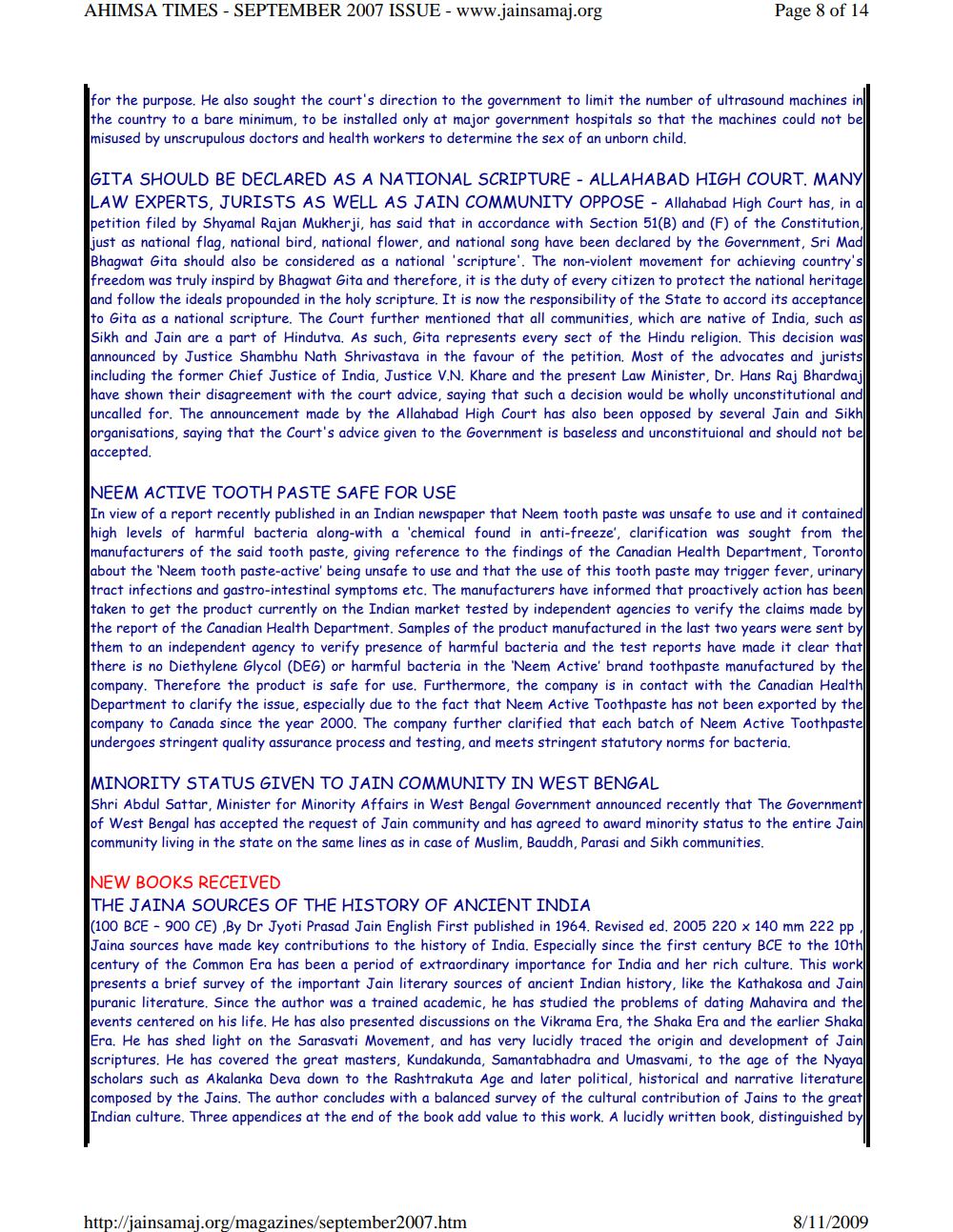________________
AHIMSA TIMES - SEPTEMBER 2007 ISSUE - www.jainsamaj.org
Page 8 of 14
for the purpose. He also sought the court's direction to the government to limit the number of ultrasound machines in the country to a bare minimum, to be installed only at major government hospitals so that the machines could not be misused by unscrupulous doctors and health workers to determine the sex of an unborn child.
GITA SHOULD BE DECLARED AS A NATIONAL SCRIPTURE - ALLAHABAD HIGH COURT. MANY LAW EXPERTS, JURISTS AS WELL AS JAIN COMMUNITY OPPOSE - Allahabad High Court has, in a petition filed by Shyamal Rajan Mukherji, has said that in accordance with Section 51(B) and (F) of the Constitution, just as national flag, national bird, national flower, and national song have been declared by the Government, Sri Mad Bhagwat Gita should also be considered as a national 'scripture'. The non-violent movement for achieving country's freedom was truly inspird by Bhagwat Gita and therefore, it is the duty of every citizen to protect the national heritage and follow the ideals propounded in the holy scripture. It is now the responsibility of the State to accord its acceptance to Gita as a national scripture. The Court further mentioned that all communities, which are native of India, such as Sikh and Jain are a part of Hindutva. As such, Gita represents every sect of the Hindu religion. This decision was announced by Justice Shambhu Nath Shrivastava in the favour of the petition. Most of the advocates and jurists including the former Chief Justice of India, Justice V.N. Khare and the present Law Minister, Dr. Hans Raj Bhardwaj have shown their disagreement with the court advice, saying that such a decision would be wholly unconstitutional and uncalled for. The announcement made by the Allahabad High Court has also been opposed by several Jain and Sikh organisations, saying that the Court's advice given to the Government is baseless and unconstituional and should not be accepted.
NEEM ACTIVE TOOTHPASTE SAFE FOR USE In view of a report recently published in an Indian newspaper that Neem tooth paste was unsafe to use and it contained high levels of harmful bacteria along with a 'chemical found in anti-freeze', clarification was sought from the manufacturers of the said tooth paste, giving reference to the findings of the Canadian Health Department, Toronto about the 'Neem tooth paste-active' being unsafe to use and that the use of this tooth paste may trigger fever, urinary tract infections and gastro-intestinal symptoms etc. The manufacturers have informed that proactively action has been taken to get the product currently on the Indian market tested by independent agencies to verify the claims made by the report of the Canadian Health Department. Samples of the product manufactured in the last two years were sent by them to an independent agency to verify presence of harmful bacteria and the test reports have made it clear that there is no Diethylene Glycol (DEG) or harmful bacteria in the 'Neem Active brand toothpaste manufactured by the company. Therefore the product is safe for use. Furthermore, the company is in contact with the Canadian Health Department to clarify the issue, especially due to the fact that Neem Active Toothpaste has not been exported by the company to Canada since the year 2000. The company further clarified that each batch of Neem Active Toothpaste undergoes stringent quality assurance process and testing, and meets stringent statutory norms for bacteria.
MINORITY STATUS GIVEN TO JAIN COMMUNITY IN WEST BENGAL Shri Abdul Sattar, Minister for Minority Affairs in West Bengal Government announced recently that the Government of West Bengal has accepted the request of Jain community and has agreed to award minority status to the entire Jain community living in the state on the same lines as in case of Muslim, Bauddh, Parasi and Sikh communities
NEW BOOKS RECEIVED THE JAINA SOURCES OF THE HISTORY OF ANCIENT INDIA (100 BCE - 900 CE),By Dr Jyoti Prasad Jain English First published in 1964. Revised ed. 2005 220 x 140 mm 222 pp Jaina sources have made key contributions to the history of India. Especially since the first century BCE to the 10th century of the Common Era has been a period of extraordinary importance for India and her rich culture. This work presents a brief survey of the important Jain literary sources of ancient Indian history, like the Kathakosa and Jain puranic literature. Since the author was a trained academic, he has studied the problems of dating Mahavira and the events centered on his life. He has also presented discussions on the Vikrama Era, the Shaka Era and the earlier Shaka Era. He has shed light on the Sarasvati Movement, and has very lucidly traced the origin and development of Jain scriptures. He has covered the great masters, Kundakunda, Samantabhadra and Umasvami, to the age of the Nyaya scholars such as Akalanka Deva down to the Rashtrakuta Age and later political, historical and narrative literature composed by the Jains. The author concludes with a balanced survey of the cultural contribution of Jains to the great Indian culture. Three appendices at the end of the book add value to this work. A lucidly written book, distinguished by
http://jainsamaj.org/magazines/september 2007.htm
8/11/2009




